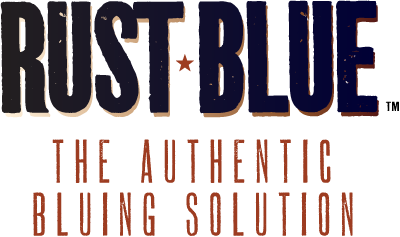Youtube video on applying Rustblue: https://www.youtube.com/watch?v=O4QOcRTZv2Q
General rust blueing instructions
(individual products may vary)
- Use silicon carbide paper up to 320 grit to prepare the steel. If a matte finish is desired then sand/bead blast the parts. Make sure all active rust is removed. You may need to use a commercial rust remover to assist in de-rusting heavily corroded parts.
- Degrease with 3 washes of naptha or acetone. Then give it a bath in a warm solution of dishwashing detergent. Rinse thoroughly with hot water. Look for “sheeting” of the water on the steel and no beading. Beading means there is still oil on the surface. You don’t want any oil on it!
- Generally, parts not coated with Rust Blue won’t rust in the blueing process. But if you desire added protection, spray any parts you don’t want to rust with clear lacquer. You can even coat the inside of the bore with it. It removes easily when you are through with lacquer thinner.
- After the metal has dried, apply the bluing solution to cold metal with a 100% cotton swab. Squeeze out the swab so it is damp but not dripping. Use long even strokes with the barest of overlap. Going back over missed areas can actually remove previous color, so avoid doing that.Allow it to dry for 2 hours (this primes the metal). Re-coat, let dry, heat metal above 100 F and put in a damp cabinet* for 4-6 hours to rust, or overnight if a damp cabinet is not available and local humidity levels are above 30%. If you use a sweat box and low pressure steam ripening can occur with in an hour. Pre-heat the metal prior to introduction to the steam to prevent spotting.
- When a fine layer of reddish-brown rust has formed (looks like reddish-brown fuzz), remove the metal, boil for 15 minutes in deionized distilled water or steam for 10 min. Then card with 000 -0000 steel wool, degreased in naptha or acetone. The word carding means to scrub off the loose oxide. Each of these cycles is called a “pass”. Repeat as many times as you need to get the color you want. This will usually be 2-4 times. Small Parts – boil in deionized distilled water or steam with tap water suspended in a 4 qt covered saucepan for 10 minutes. Larger parts such as barrels can be boiled in special tanks available from Brownells or you can make a steam pipe apparatus** from PVC pipe and fittings obtained from a local home improvement store.
- When satisfied, you can apply oil, wax, lacquer or boiled linseed oil to seal the metal pores.
Complete directions for the steam pipe come with each order.
* Damp cabinet/dry heater – A damp cabinet is any box or container that has a source of moisture in it. It is like a big humidor. But just for gun parts and not cigars! A great damp cabinet can be made from a clothing wardrobe available from a moving company. Simply place a source of moisture in the bottom (a wet towel works well as does a pan of water) and hang your work on the cross bar. A shower can be used by hanging the metal from the shower curtain rod and suspending it over a tub of water. Wait 6-12 hours for the rust to form. A one room steam vaporizer is the best way to get a fast rust. Just place the vaporizer in the box, vent the top and steam for 30-45 minutes or until you get a ripe rust. Small clothing steamers work well too. The damp cabinet box can also double as a dry heater by using a small electric space heater in place of the vaporizer or steamer.
**If you build the steam pipe apparatus, a barreled action can be suspended inside the pipe, then covered and allowed to rust using it as a damp cabinet. All you need is a 3-4 ft length of cellular core PVC (used for sewer pipe), a flat-lidded pot, wooden dowel, 3 in toilet flange and a gas burner. Punch some holes in the pot lid and screw the toilet flange to it. Notch one end of the pipe to accept a length of dowel. Boil tap water in the pot, place the pipe over the flange and hang the barrel/barreled action from the dowel. Cover the top with a towel or aluminum foil and steam for 10 minutes. For small parts, placing them in a covered pot with a small amount of water in the bottom does the trick. Place the parts in the pipe over cold water and use it as a damp cabinet to hasten rusting. Don’t leave it more than 8 hrs or you could get pitting.
